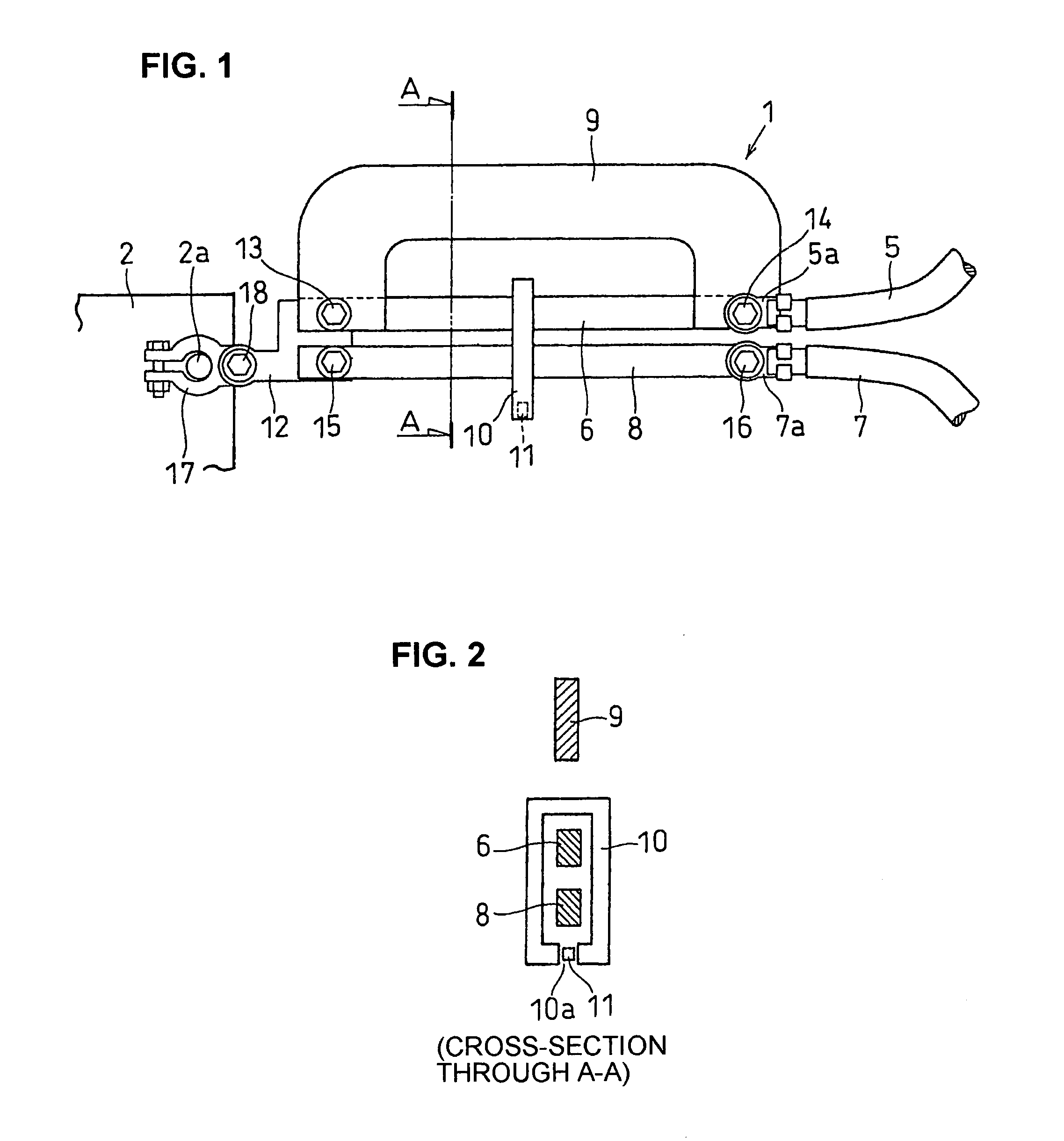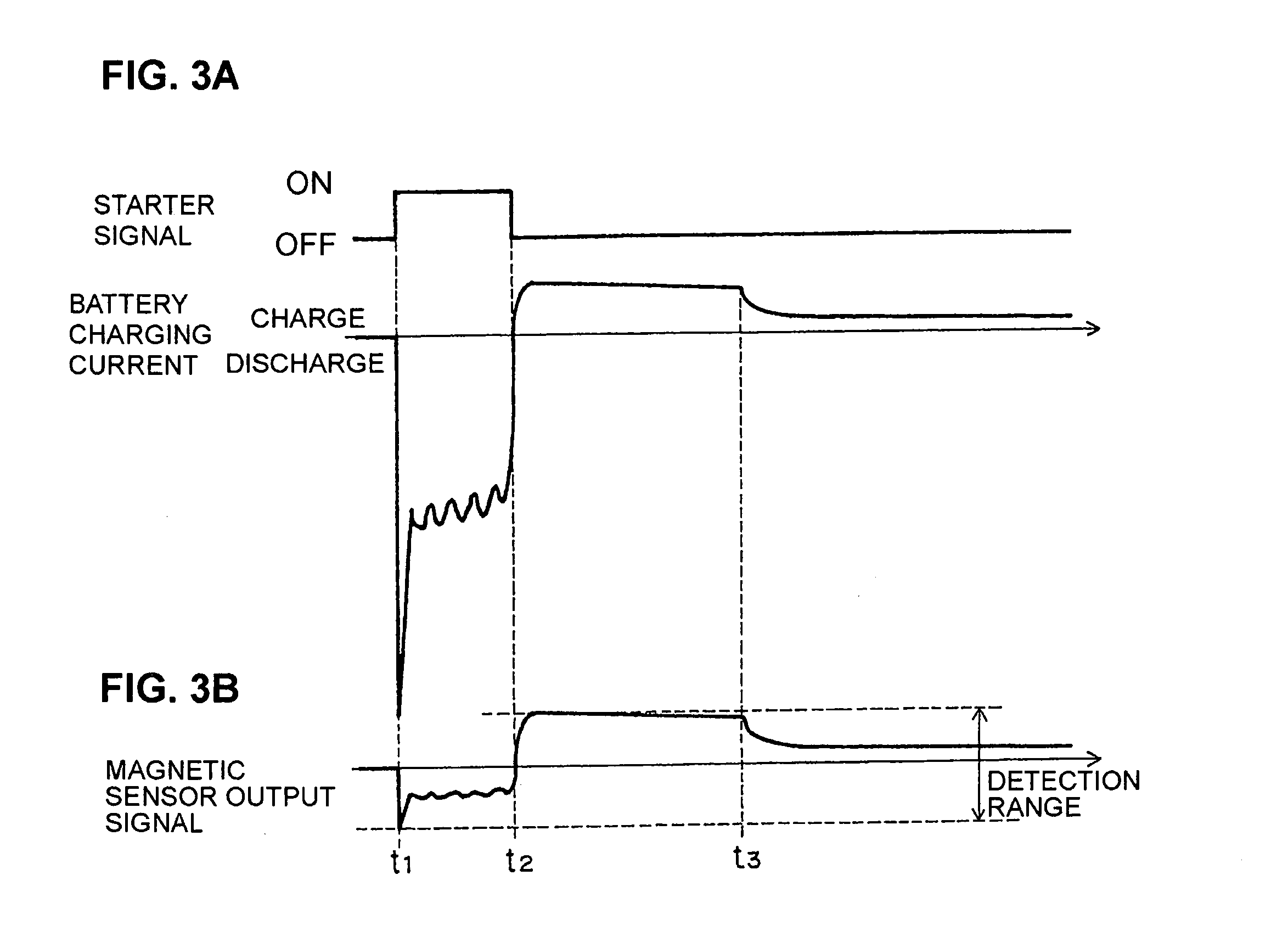Electric current detection apparatus
a detection apparatus and current technology, applied in the direction of instruments, base element modifications, transportation and packaging, etc., can solve the problems of inefficient measurement, difficult to find space for mounting the electric current detection apparatus, and respect for detection accuracy, so as to achieve accurate determination
- Summary
- Abstract
- Description
- Claims
- Application Information
AI Technical Summary
Benefits of technology
Problems solved by technology
Method used
Image
Examples
first embodiment
[0041]FIG. 1 is a plan view of an electric current detection apparatus 1 according to a first embodiment. This is applicable for example to a battery status monitoring system such as that shown in FIG. 7 (described in more detail hereinafter), for detecting a starting current that flows from a battery 2 to a starter motor 3 (also shown in FIG. 7) when starting of a vehicle engine is performed, and for monitoring a charging current that flows from a generator 4 of the vehicle into the battery 2, and moreover for detecting a discharge current that flows from the battery 2 to other electrical equipment of the vehicle (such as headlamps, air conditioner, navigation apparatus, etc.).
[0042]FIG. 2 is a cross-sectional view taken through a plane A—A indicated in FIG. 1. As shown in FIG. 1, the electric current detection apparatus 1 is made up of a 1st conductor 6 that is connected to a 1st supply lead 5 of a first current path, a 2nd conductor 8 that is connected to a 2nd supply lead 7 of a...
second embodiment
[0061]FIG. 4 is a plan view of an electric current detection apparatus, designated by numeral 100, according to a second embodiment. In FIG. 4, components corresponding to components in the electric current detection apparatus 1 of FIG. 1 are indicated by reference numerals respectively corresponding to those in FIG. 1, and detailed description of these will be omitted. With the first embodiment described above, the 1st conductor 6 and the 3rd conductor 9 are connected mutually in parallel and are connected in common to the 1st supply lead 5. Hence at the time of engine starting, the starting current branches through the 1st conductor 6 and the 3rd conductor 9, thereby reducing the proportion of the starting current that flows through the first conductor 6. However with the second embodiment, there is no reduction of the proportion of the charging current that flows through the 1st conductor 6 during engine starting. Instead, the magnetic flux that is generated by the flow of normal...
third embodiment
[0072]FIG. 6 is an oblique view of a battery module 19 according to a third embodiment of the invention. With this embodiment the electric current detection apparatus 1 of the first embodiment (or the electric current detection apparatus 100 of the second embodiment) attached within a case that is formed of a material such as synthetic resin, cast aluminum, etc., is mounted on a battery 2 as shown, to thereby constitute a battery module 19. Since the electric current detection apparatus 1 is directly mounted on the battery 2, the connecting lead between the electric current detection apparatus 1 and the terminal 17 the battery 2 can be very short, and space saving can be achieved.
PUM
 Login to View More
Login to View More Abstract
Description
Claims
Application Information
 Login to View More
Login to View More - R&D
- Intellectual Property
- Life Sciences
- Materials
- Tech Scout
- Unparalleled Data Quality
- Higher Quality Content
- 60% Fewer Hallucinations
Browse by: Latest US Patents, China's latest patents, Technical Efficacy Thesaurus, Application Domain, Technology Topic, Popular Technical Reports.
© 2025 PatSnap. All rights reserved.Legal|Privacy policy|Modern Slavery Act Transparency Statement|Sitemap|About US| Contact US: help@patsnap.com



